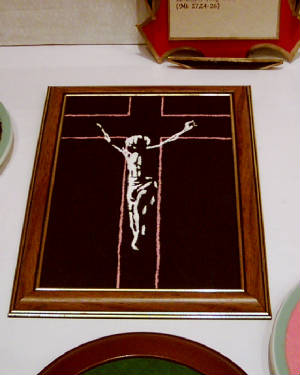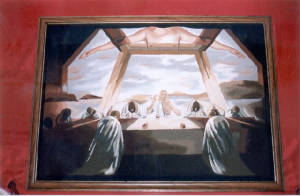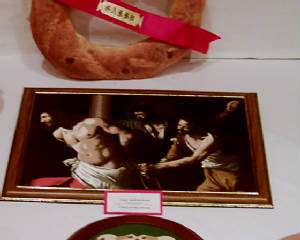|
THE PASSOVER MEAL AND
THE LAST SUPPER
In the Old Testament, Book of Exodus Chapter XII, God commanded his people to keep
alive the memory of their deliverance from Egyptian bondage by holding the Passover Meal and explained in detail how this
should be celebrated. In the New Testament, Jesus wanted to adhere to this Jewish tradition by holding the Last Supper with
His Apostles on the eve of his death.
Spread out before you is the table as the Apostles must have prepared it according
to the Jewish tradition. On entering the house, it was the custom for guests to have their feet washed by the household servants,
hence the pitchers, basins and other vessels in the recess of the table. You can see oil lamps, wine and water vessels, pitchers
and bowls for the ritual washing.
In front of the head of the table, in this case Jesus, is one large cup, a chalice,
from which guest drank wine four times during the meal. The plates in front of each Apostle served as a receptacle for crumbs
or remains of food.
The main food for the Passover Meal was the roast lamb, the unleavened bread, bitter herbs in the
shape of bricks, and the Haroseth, a mixture of dried fruits, nuts, spices and herbs. Over the ages the Jews introduced various
other food such as dates and pomegranates, their dessert and also eggs, representing the source of life. In a separate bowl
containing a mixture of oil, vinegar, wine and spices, each guest dipped a piece of the bitter herbs. The lamb was, as aforesaid
roasted and the Jews had to consume it completely, head and entrails included, without breaking any bones.
The unleavened
bread depicts the hasty departure with which the Jews fled from Egypt. The bitter herbs consisting of endive and chicory cooked
with dried figs and tomatoes to a solid consistency in the form of bricks, symplize the hard times the Jews endured under
the Egyptians. The official meal proceeded more or less, in the following manner. An hour after sunset, the guests, numbering
about twenty, assembled in the house of a relative or friend. There was, then the ritual washing of feet, which in the case
of Our Lord's Last Supper, was done by Christ Himself. Where the washing of the feet was over, the head of the group prepared
the first wine cup by mixing two parts water with one part one. This was followed by the blessing of the bread. Each one then
partook of the first chalice. At this point the food was brought in. The head of the table washed his hands, then taking a
piece of the bitter herbs, he dipped it in the bowl with the vinegar mixture.
This custom explains why Jesus said "He
who dippeth his hand with me in the dish, he shall betray me". A blessing was then said on the fruits of the earth, the head
started to eat and invited the others to do likewise. Here the second chalice was blessed. It was at this second chalice that
Our Lord instituted the Blessed Eucharist. On the side you can see the Jewish Book of Law open at Chapter XII of the Book
of Exodus which the Jews call the Torah. The passage narrating the deliverance of the Jews from Egyptian bondage was read
by the head of the family in answer to the ceremonial question put to him by the youngest member of the family, which was
"What is the meaning of this meal?" The seven-branched candelabrum which stands near the Book of Law, symbolizes the presence
of God. The meal ended with the chanting of various psalms of praise to God known as the Hallel. The decorative plates with
different kind of pasta are symbols from the Bible and symbols of the Apostles.



|

